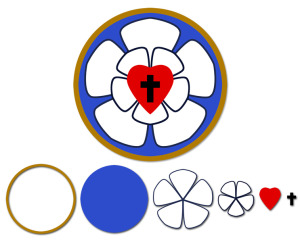Martin Luther is known for: being a brilliant theologian, a key figure in the Protestant Reformation, translating the Bible from Latin into the common tongue, being a bit of a hot head that used colorful language, and also for writing wonderful hymns.
I have re-drawn Luther’s mandala slightly to make it more graphic. What Luther did was use Christian symbols and liturgical colors. The symbols and colors break out as follows:
Gold outer ring: The circle is the Christian symbol for God. Gold is the color of divinity.
Blue backdrop: Blue, the color of the sky, symbolic of heaven and truth.
White rose: White is the color of purity. This rose is symbolic of purity as well as a cleansed state.
Red Heart: The heart is symbolic of the deep inner person, the soul and/or spirit. Red again is typically the color of blood. It is also the liturgical color for Pentecost.
Black Cross: The cross refers to the central work of Christ. Black is the color of death. Note the centrality of the cross in Luther’s mandala.
This simple little mandala built out of Christian symbols has a profound meaning for me. We begin at the center of the image and work out.
I believe, in my heart, in my deepest self, in the sacrificial/substitutional work of Jesus at the Cross.
By grace, my belief puts me in a pure/cleansed state. Because I am cleansed I am an acceptable place for the Holy Spirit to inhabit. The Holy Spirit is in me.
I live by faith and together with all Believers anticipate a Heavenly inheritance.
My guess is that Luther had 2 Corinthians 1:21-22 in mind:
21And it is God who establishes us with you in Christ, and has anointed us, 22and who has also put his seal on us and given us his Spirit in our hearts as a guarantee.
The imagery and it arrangement in the mandala allows me to understand the thinking of a German guy born over 500 years ago.
In Part 3 we visit Stanford University to look at a 100 year old Christian mandala in Memorial Church, or, MemChu as we called it as students.

